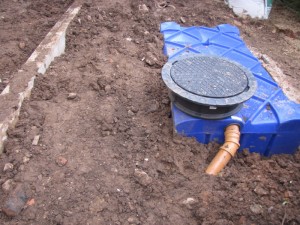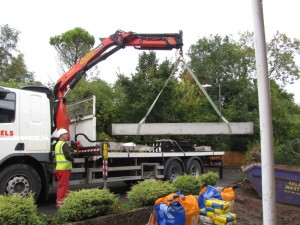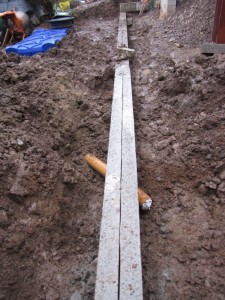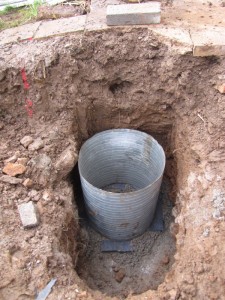A ‘blue moon’ opportunity whilst we have the, one and only, chance to ever get a digger into this part of the site, so we invest in, well, a blue water tank. This will connect the rainwater discharge from the rear roof slope and the rear extension roof. It is a 1500 litre tank, about the size of 8 standard water butts – not huge, but as big as we can get into the space without major civil works and it will serve only to water the garden. The tank is a shallow dig unit from RainWater Harvesting. The photo shows the tank part-connected – with just the overflow connected to the underground surface water drain.
Daily Archives: October 5, 2012
week 7: giant lintels arrive
The ground bearing lintels arrive: these will sit on top of the concrete pipes. They are huge: 290 x 100mm and 3.5m long, and incredibly heavy. Having perhaps sounded a little smug about the amount of concrete saved (in the previous post), I don’t think we will have saved much financially. These lintels are specials and have cost a small fortune!
The photo above shows the lintels in place. Two 100mm wide lintels are placed side-by-side, allowing the 200mm aerated concrete blocks to be built straight off the lintels. Hopefully we’ll be out of the ground soon.
week 7: foundings cast
We bury a scandalous amount of concrete in this country to prop up our buildings. I was keen to ensure that our structural engineer came up with a ‘creative solution’ to mitigate the amount needed, as we have had to go so deep to ensure we are below the level of the sewer. The concrete ‘pipes’ seems a good solution and getting hold of the steel ducts was a good find by the contractor. The picture above shows one of the four ducts for the founding ‘moulds’ placed in-situ ready for the concrete pour. In total, we need 2.5m³ of concrete as opposed to 8.75m³ with a traditional deep trench fill, a saving of 70% of grey stuff.




